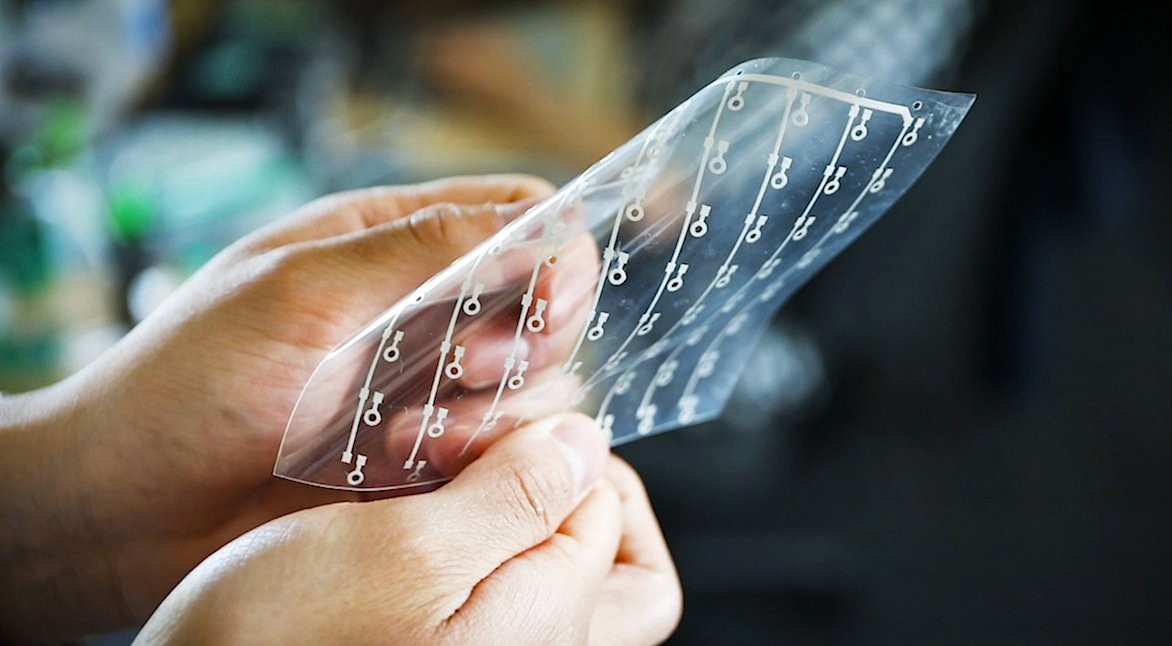Flexible Conductive Inks: A Pillar In Electronics Innovation

Flexible conductive inks enable electronics devices to revolutionize industries from healthcare to automotive. Learn about their properties, the benefits they bring, their applications, substrates they’re printed on, and where you can purchase them.
Introduction
Estimated read time: 3 minutes
We are witnessing a period of unprecedented growth in the printed electronics industry, driven by advancements in flexible applications such as sensors and displays.
What started as flexible circuits in metal conductors on paraffin coated paper [1] has become electronics in novel form factors, like wearable smart contact lenses and curved displays. The revolutionary nature of this next generation of electronics is being driven by industries like healthcare, energy solutions, automobile design, and more.
While each industry will benefit differently, the common characteristic they share is flexibility — fueling developments in both substrates/films and conductive inks.
What Are Flexible Electronics?
Flexible electronics are devices assembled by mounting flexible components onto bendable, stretchable, or conformable substrates. They are used for biomedical sensors, wearables, flexible batteries, environmental sensors, and more.
What Are the Benefits of Flexible Electronics?
There are a number of benefits to using conformable, stretchable, or flexible substrates and films, such as:
Customization
The ability to conform to specific dimensions enables greater customization and differentiation during product development compared to rigid electronics.
Weight reduction
Flexible substrates such as polymer films are lightweight in nature. In industries like aerospace and automobile design where weight saving is an important factor, flexible electronics offer a significant advantage.
Durability
In applications subjected to continuous mechanical stress or vibrations, like structural monitoring, flexible electronics can better adapt to the environment to withstand harsh conditions.
Cost reduction
While the initial material cost for flexible electronics is higher than rigid electronics, flexible circuits are easier to manipulate into different shapes and sizes. This reduces the device size, saving on production costs in the long run.
Flexible Conductive Inks
It’s not enough to print on flexible substrates. You also have to print with flexible material (for example, flexible conductive ink). As substrates undergo mechanical tension from bending or creasing, the printed traces need to withstand the force and maintain conductivity and shape.
When it comes to formulating ink, you will find most materials have the necessary characteristics to withstand these conditions. Conductive inks are comprised of two major components:
- The filler —The functional part of the material, typically consisting of metal particles that make the ink conductive.
- The vehicle —This is the area in which most flexible inks differ from stretchable inks. The vehicle is all the other components like binders, additives, and solvents, which suspend the particles and give the ink its structural properties. Flexible ink formulations will prioritize polymer additives that provide a structure capable of withstanding mechanical tension from flexing or creasing, while stretchable ink formulations include additives that when cured, prevent the traces from cracking after being stretched.
Graphene
An example of a flexible application is medical sensors, which require biocompatible substrates and inks for on-skin or in-body biometric monitoring. Graphene-based conductive inks are highly favored for printing flexible electronic applications such as medical sensors because of the materials’ mechanical flexibility and high conductivity.
Silver
In other use cases, such as producing thin conductive films, silver is often used due to its lower cost, low melting point of its nanoparticles, and high thermal and electrical conductivity.
Silver/silver chloride
Silver/silver chloride (Ag/AgCl) is another common material and, similar to graphene, is often used for biomedical monitoring applications. Given its biocompatibility and mechanical robustness, it was used recently at York University in Toronto where researcher Yoland El-Hajj used Voltera’s NOVA materials dispensing system to print Ag/AgCl biomedical electrodes onto tattoo paper.
How Do I Choose a Flexible Ink?
Finding the right material for your application can seem like an intimidating task. We created a compatibility guide for inks and substrates to provide you with the information you need to make an informed decision.
Some notable flexible ink suppliers include:
Webinar: Printing Electronics With Flexible Inks
Do you want to learn more about printing flexible hybrid electronics? Are you curious about how to find the right materials to use with Voltera’s dispensing system, NOVA?
In this webinar, Andrew Bambach, Application Engineering Manager/SE Product Manager at ACI Materials, presents:
- Their line of Alchemy conductive inks
- Their new low-temperature solder paste, which enables reflow soldering on PET substrates and effectively replaces traditional flex PCBs
In addition, we provide a live demonstration of NOVA’s features, including:
- Calibrating a new material
- Using the materials library
We also provide:
- An overview of NOVA
- A demonstration of the software
- A sample of a completed, cured print
References
[1] Baruah RK, Yoo H, Lee EK. Interconnection Technologies for Flexible Electronics: Materials, Fabrications, and Applications. Micromachines. 2023; 14(6):1131. https://www.mdpi.com/2072-666X/14/6/1131
Related Articles









